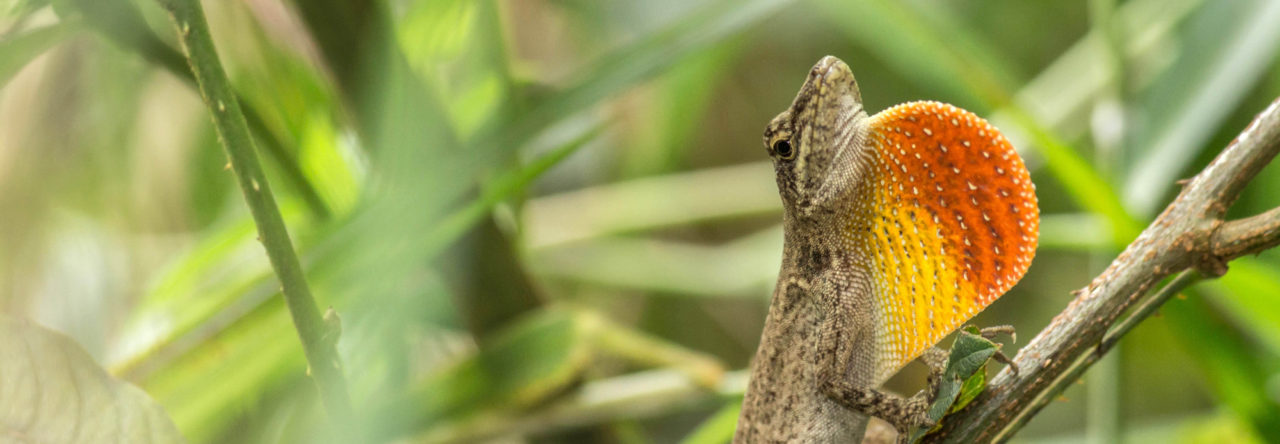In a fascinating new paper, Ivan Prates and colleagues report on a phylogenetic analysis of Amazonian Dactyloa clade anoles with implications for a number of important topics in anole evolution.
The authors generated new mitochondrial and nuclear gene data for many Amazonian Dactyloa and combined those data with existing data from previous studies. Of particular note was inclusion of Anolis dissimilis, until recently known from only a single locality, and the Amazonian horned anole, Anolis phyllorhinus.
The paper had four main results, which I’ll go through seriatim. First, the overall phylogeny is very much in accord with Castañeda and de Queiroz’s previous work. The biggest difference is that A. dissimilis occurs in a distinct clade with A. neblinus and A. calimae. A relationship between the latter two species had been suggested by the previous work; A. dissimilis had not been included in those studies. The three species have quite disjunct geographic distributions (Amazonia, western Colombia, and the tepuis of the Guiana Shield, so finding them to comprise a distinct clade is interesting.

Anolis punctatus. You can almost see a horn ready to burst forth from the tip of that snout. Photo by Arthur Georges.
Second, as the figure below illustrates, A. phyllorhinus, as expected, groups with A. punctatus, whereas A. proboscis groups with the phenacosaurs (heterodermus group; though A. proboscis is not actually included in the analysis because genetic samples were not available; however, recent studies clearly indicate that A. proboscis belongs with this clade). Prates et al. note that, other than the horn, A. phyllorhinus and A. punctatus are morphologically very similar. I’ll take that one step further–you can almost imagine the antecedents of the horn as a swelling on the tip of the snout of A. punctatus. And, in addition, note that the horns of the two-horned species are very different-looking. Although Williams placed them in the species group, he did note that they actually didn’t look at that much alike. We now know that he was correct in this observation–hornedness is a convergent trait in anoles (no, I’m not calling it horniness).
Third, Prates et al. calculated divergence times, calibrated with three fossils that can be confidently placed in iguanian phylogeny. Their analysis indicated that Dactyloa diverged from the rest of anoles about 49 million years ago, and Norops began diversifying about 24 mya. These numbers are in line with all other recent molecular studies (discussed most recently in the context of the Mexican amber anole, A. electrum) and are about half the age of the dates proposed by Nicholson et al. This would seem to be yet another nail–the final?–in the coffin of the idea that anoles are old enough to account for their occurrence in the Caribbean by vicariance.
 Lastly, the paper looked at relationships between A. phyllorhinus, A. punctatus, and the little known A. philopunctatus. The latter are indistinguishable from A. punctatus except that they have a yellow dewlap with black spots, whereas A. punctatus usually has an orange dewlap…except for several populations with a white dewlap. And A. phyllorhinus has a red dewlap.
Lastly, the paper looked at relationships between A. phyllorhinus, A. punctatus, and the little known A. philopunctatus. The latter are indistinguishable from A. punctatus except that they have a yellow dewlap with black spots, whereas A. punctatus usually has an orange dewlap…except for several populations with a white dewlap. And A. phyllorhinus has a red dewlap.
The analysis found that A. phyllorhinus is sister to the others, but both the white-dewlapped A. punctatus populations and A. philopunctatus are nested within orange-dewlapped A. punctatus. The question then arises whether the distinct dewlap populations are reproductively isolated, or just represent color variants with no greater significance. The authors rightly note that more data are needed to address this fascinating question, but decide to, very tentatively, consider A. philopunctatus to not be a distinct species, but rather to consider it part of A. punctatus.
- Evolution in Real Time on Lizard Island - March 23, 2025
- Spider Snags Adult Anolis osa - March 22, 2025
- An Homage to the Green Anoles of New Orleans - March 21, 2025








Kirsten Nicholson
Neat stuff, and they used our genera! LOL 😉
N Manwaring
Is there a photo anywhere of Anolis laevis? Lots out there of Anolis phyllorhinus and Anolis proboscis, but I can’t even find a preserved specimen shot of A. laevis.
Jonathan Losos
If I’m not mistaken, A. laevis is known from a single specimen collected more than a century ago, which explains the lack of photos.